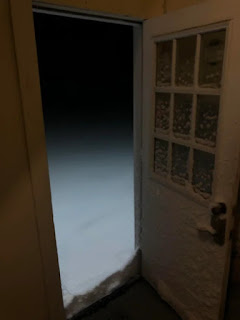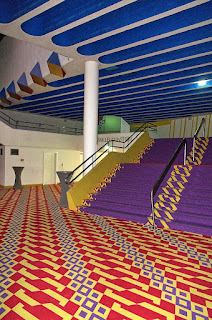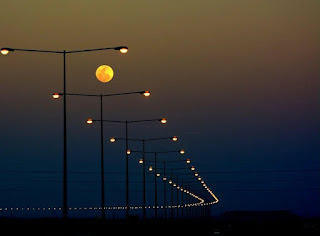THE HAUNTING OF OUR IMAGINATIONS
the sudden appearance of liminal space
By Rubi Sanmiguel
.jpeg) |
| What's wrong? |
The definition of a Liminal Space is not a concrete one, but it builds off of the literal origin of the word liminal: the quality of ambiguity or disorientation that occurs in the middle stage of a rite of passage. When we apply the idea of a middle stage to a location, we get places like hallways, airports, and schools, in-between places that we pass through as we travel from place to place. The same concept can also be applied to the self and our experiences of passing through time, such as adolescence, where we’re uncomfortably between childhood and adulthood. We can assign other specific examples of these places such as homes, stores, malls, playgrounds, rural roads, gas stations, hospitals, and other places destinations where we spend small amounts of time. These places are not scary or eerie. They’re normally bustling with customers and employees, other children, people living their day-to-day lives, and it is this day-to-day context which makes them comforting.
But what happens when something is stripped of its expected context? What does it mean when a home is stripped of furniture and completely deserted? When a store in a mall is dark and abandoned? When a road stretches on for miles, never coming to an end? When the situation does not match up with our preconceived notions, we feel uncomfortable. Schools should be busy with students, roads should lead somewhere, offices should have workers in them. When these places are dark, empty, and desolate, we can’t help but struggle to make sense of what happened. Why are these places suddenly completely empty? Where did the people go?
 |
| Where am I going? |
Our lack of understanding about what happened inspires feelings of fear and unease. We don’t know what happened, so we cannot help but imagine the horrible things that may have transpired. Another interpretation is that the very familiarity of these places makes their lack of activity feel like a fuzzy dream or a half-forgotten memory. It jars us into thinking about these places instead of letting them lay dormant at the back of our minds. Along with that nagging feeling of almost knowing, key characteristics include a complete lack of people, low-fidelity visuals with noise or artifacting, unusual architecture, lack of consistent lighting, and other similar effects. The ambiguity of these effects allows for infinite interpretations through not just photography, but 3D renderings, video, special effects, AI generated images, photobashing, video games, and other visual media.
The first thing we notice about the above photograph is the amateurish and uneven lighting, as if it were taken in a poorly lit room with the flash of a cheap camera. There’s compression artifacting and a slight fuzziness to the image, particularly evident when looking at the darkened back walls. Both visible doorways are dark and illegible, along with a strange pitch-black shape seemingly leaning down from the top of the stairs. The strange architecture is redundant: two stairways leading to the same area; an empty corner with no doorways; and a pathway on the upper left side of the image that leads to nowhere. The color and style is reminiscent of American suburban interior design: a warm beige paint and white trim; and barely visible brown carpeted stairs. This element in particular triggers a sense of nostalgia, especially when combined with the aforementioned odd architecture, unclear lighting, and strange artifacting. It’s a perfect and highly effective Liminal Space photograph.
 |
| That's a lot of pattern |
This image above is recognizable as some sort of public gathering space, such as a movie theater or museum. The image has no dark or obscured areas like the previous example, and we don’t have much context as to what a normal version of it might be. The absurd architecture and strikingly unnatural lighting carry the image into liminal space territory: The nonsensical placement of a ceiling light, the deep blue grooves in the unusually low ceiling, and the metallic geometric shapes jutting into a corner, and the unidentifiable hourglass-shaped furniture are all confusing and abnormal. The oddly flat CGI-esque lighting is disorienting and even further disconnects us from the original purpose of the environment.
The photograph below is starkly different from the previous, and yet it still invokes the same dreamlike quality. As we look further into what makes an image “liminal”, we see the pattern of something being “wrong”, unusual, out of place, or unintelligible. It’s as if we can’t immediately come to a conclusion as to why it looks the way it does. It’s unnatural and unusual, out of place and it warps the entirety of our sense of reality.
 |
| Losing liminality |
In this rather stunning photo above, it’s hard to miss the fake foliage, grass, rocks, and even sky, especially as the small house is enclosed in a room painted to look like the outside world. But the image is brightly lit and we can attribute a perfectly sensible guess as to where we are or what this is: It could be a miniature golf course or a museum exhibit, neither of which possess the transient quality of typical liminal space locations. There is no ambiguity to be found in the image, and if anything, it looks charming and fun.
Interestingly, the photograph is part of a photo set, in which we can find a much more effective liminal image:
 |
| Suddenly liminal |
This photo, taken from what we can assume to be the inside of the house, gives off a much stronger feeling of discomfort. These two images aren’t that different: they’re high-fidelity images that contain no artifacting or especially strange lighting. They’re depicting the same location, so why does the second image so much more successfully inspire feelings of unease?
A likely reason is that the angle of the photo removes a lot of the context that we saw in the first image. We don’t see the walls of the outer room, nor do we see the large area of grass, both of which give us clues as to how the room functions. Those clues are stripped away, and instead, we’ve lost any knowledge of anything typical or comfortable. We have no idea where we are. Is there anything that actually looks like this? The scale seems small with only a small part of the ceiling visible, and the color contrast of the bright yellow walls and the blue-tinted “outside” is even further disorienting.
Overall, liminal space photography preys on our innate desire to understand. Through its subversion of expectations, we lose our sensibility, our knowledge of what we should be doing and what our surroundings mean for us. We know that the information is incorrect, and when incorrect information is visual, we feel startled and depersonalized. The world is not as we are supposed to know it, and so where are we?
The sense of self is what we know best, which is why the depersonalization that comes from liminal spaces is so startling. The strange and confusing environments look like reality, yet aren’t: We feel we do not belong here. The “self” should not exist here. Our imaginations run free with ideas of what this world may look like and what else could be strange and jarring in architecture or physics itself. What would it feel like to wander through a world of computer-generated lighting and repeating textures? How about miles and miles of city blocks, completely void of life? How would it feel to be lost in a home full of endless twisting hallways and staircases, full of dark corners and empty rooms?
 |
| Path in the sky or the ground |
We’ve only experienced snippets of these realities, whether in an office or school long after hours, or during a global pandemic where busy highways are completely empty. It’s being where we don’t belong; seeing what we’ve never seen before. Liminal space photography captures that elusive moment in time, and captures the feelings of uncertainty and intrigue that come with it. The photos are of places we may have never been before, but feel as if we have; like a dream of a familiar place that doesn’t look like the real place at all.
These glimpses into strange realities frozen in time are reminiscent of the surrealist movement of the 1920s, of René Magritte’s out-of-place items and Salvador Dalí’s infinite landscapes. The surrealist movement, like the emergence of liminal space photography, occurred after a sudden and jarring period of hardship and social turmoil, with World War I and the Covid-19 Pandemic transforming our relationships with the environment we reside in.
Both movements capture the topical feelings of constant underlying fear and uncertainty of one’s surroundings, portraying these abstract sensations as visual pieces. With the latter in particular, we were inspired with feelings of seemingly inescapable loneliness, a fear of our environments, and a harsh disruption of normality. These feelings, combined with the imagery of empty streets and buildings, provided the perfect foundation for the emergence of the liminal space art movement.
©Rubi Sanmiguel and the CCA Arts Review


No comments:
Post a Comment